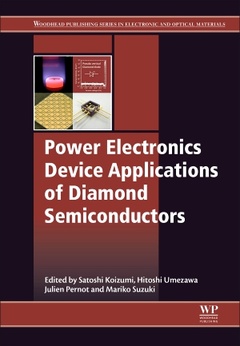Description
Power Electronics Device Applications of Diamond Semiconductors
Woodhead Publishing Series in Electronic and Optical Materials Series
Coordinators: Koizumi Satoshi, Umezawa Hitoshi, Pernot Julien, Suzuki Mariko
Language: English
Subject for Power Electronics Device Applications of Diamond...:
Keywords
ALD Al2O3; Atomically flat surface; Avalanche mechanism; BJT; Barrier inhomogeneity; Benchmark; Bisas enhanced nucleation; Boron; Breakdown; Breakdown voltage; CIRA; CVD; Cathodoluminescence; Chemical vapor deposition; Conductivity modulation; Contact resistance; Critical damage level; Current density; C-H bond; C-V characteristics; Defect; Devices performance; Diamond; Diamond power devices; Diffusion length; Dislocation; Dislocations; Dynamical annealing; Edge-termination technique; Electron; Electron emitters; Evaluating a crystal structure; Excitons; Field-plate; Figure of merit; Forward conduction; H-termination; HPHT; Hall measurements; Hetero-epitaxial diamond substrate; Heteroepitaxial growth; High temperature operation; Hole; Homoepitaxial growth; Hopping conduction; Impurity doping; Infrared absorption; Interface; Ion implantation; Iridium; JFET; MESFET; MOSFET; Minority carrier injection; Mobility; Modeling; Monocrystalline; N-type doping; O-termination; Ohmic; On-resistance; P-type doping; Phosphorus; Photoconductivity; Polycrystalline; Power device optimization; Power electronics; Radiation damage; Raman; Reverse blocking; Reverse recovery; Roughness; Scattering; Schottky; Schottky barrier diode; Schottky-pn diode; Self-heating; Semiconductors; Silicon; Silicon carbide; Stacking fault; Step-terrace; Stress; Surface structure; Switching; TLM; Turn-off; Two-dimensional hole gas; Wafer; Wide bandgap semiconductors; X-ray topography
466 p. · 15x22.8 cm · Paperback
Description
/li>Contents
/li>Readership
/li>Biography
/li>Comment
/li>
Power Electronics Device Applications of Diamond Semiconductors presents state-of-the-art research on diamond growth, doping, device processing, theoretical modeling and device performance. The book begins with a comprehensive and close examination of diamond crystal growth from the vapor phase for epitaxial diamond and wafer preparation. It looks at single crystal vapor deposition (CVD) growth sectors and defect control, ultra high purity SC-CVD, SC diamond wafer CVD, heteroepitaxy on Ir/MqO and needle-induced large area growth, also discussing the latest doping and semiconductor characterization methods, fundamental material properties and device physics.
The book concludes with a discussion of circuits and applications, featuring the switching behavior of diamond devices and applications, high frequency and high temperature operation, and potential applications of diamond semiconductors for high voltage devices.
2. Doping and semiconductor characterizations
3. Fundamental material’s nature of diamond
4. Device formation and the characterizations
5. Circuits and applications
materials scientists, electric engineers, and physicists studying wide bandgap semiconductors for power electronic applications
Hitoshi Umezawa studied electrical engineering and materials science at Waseda University, Japan, where he graduated in 2002 with a doctoral degree in engineering. After that, he became a Post-Doc at Waseda University financed by Japan Society of the Promotion of Science (JSPS). In 2005 he became a researcher at Diamond Research Center in National Institute of Advanced Industrial Science and Technology (AIST), Japan. He teaches semiconductor devices and power electronics as a visiting professor at Chiba University, Japan. He is lanef Chair, whom the research activities are funded by University Grenoble Alpes, France. His research interests include diamond growth and characterization, high power and high frequency devices and related device fabrication processes. He has more than 120 publications in refereed journals.
Julien Pernot is Professor at University Grenoble Alpes and Institut NEEL/CNRS, (France). He is Chair of the Department of Electronics Electrical Engineering Control and Systems at University Grenoble Alpes. Julien received his PhD degree at the University of Montpellier (France) in 2001 where he worked on the electrical transport properties of s
- Includes contributions from today's most respected researchers who present the latest results for diamond growth, doping, device fabrication, theoretical modeling and device performance
- Examines why diamond semiconductors could lead to superior power electronics
- Discusses the main challenges to device realization and the best opportunities for the next generation of power electronics




